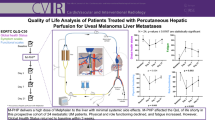Abstract
Background
Isolated limb infusion (ILI) has been associated with persistent edema, numbness, pain, and functional impairment of the treated limb. However, health-related quality of life (HRQOL) has not yet been assessed using a validated questionnaire.
Methods
Functional Assessment of Cancer Therapy-Melanoma (FACT-M) questionnaires were collected from subjects enrolled a phase I ILI trial with temozolomide at baseline and 2, 6 weeks, and 3 months post-ILI. Of 28 enrolled patients, 19 patients received maximum tolerated dose of temozolomide and are included in the HRQOL analysis. Clinical and operative variables and treatment response data also were collected.
Results
HRQOL scores showed a trend of improvement from baseline through 3-months post-ILI as measured by FACT-M and the melanoma surgery scores. There were no differences in HRQOL when patients were stratified by disease burden, clinical toxicity level, and 3-month disease response. Additionally, fewer patients complained of pain, numbness, and swelling of the affected limb at 3 months post-ILI compared to baseline, and also these symptoms were improved at the immediate postoperative visit compared with baseline.
Conclusions
Despite the known morbidity of ILI, we have demonstrated with a validated HRQOL questionnaire that HRQOL is not adversely impacted at therapeutic doses of temozolomide delivered intra-arterially from baseline through 3 months posttreatment. Patient centered-outcomes should be evaluated as a standard part of all future regional therapy trials using standardized melanoma-specific HRQOL questionnaires to more completely evaluate the utility of this type of treatment strategy.



Similar content being viewed by others
References
Beasley GM, Caudle A, Petersen RP, et al. A multi-institutional experience of isolated limb infusion: defining response and toxicity in the US. J Am Coll Surg. 2009;208(5):706-15.
Beasley GM, Petersen RP, Yoo J, et al. Isolated limb infusion for in-transit malignant melanoma of the extremity: a well-tolerated but less effective alternative to hyperthermic isolated limb perfusion. Ann Surg Oncol. 2008;15(8):2195-205.
Ueno T, Ko SH, Grubbs E, Pruitt SK, Friedman HS, Tyler DS. Temozolomide is a novel regional infusion agent for the treatment of advanced extremity melanoma. Am J Surg. 2004;188(5):532-7.
Balch CM, Gershenwald JE, Soong S-j, et al. Final Version of 2009 AJCC melanoma staging and classification. J Clin Oncol. 2009;27(36):6199-206.
Thompson JF, Kam PC, Waugh RC, Harman CR. Isolated limb infusion with cytotoxic agents: a simple alternative to isolated limb perfusion. Semin Surg Oncol. 1998;14(3):238-47.
Cormier JN, Davidson L, Xing Y, Webster K, Cella D. Measuring quality of life in patients with melanoma: development of the FACT-melanoma subscale. J Support Oncol. 2005;3(2):139-45.
Cormier JN, Ross MI, Gershenwald JE, et al. Prospective assessment of the reliability, validity, and sensitivity to change of the Functional Assessment of Cancer Therapy-Melanoma questionnaire. Cancer. 2008;112(10):2249-57.
Cella DF, Bonomi AE, Lloyd SR, Tulsky DS, Kaplan E, Bonomi P. Reliability and validity of the Functional Assessment of Cancer Therapy-Lung (FACT-L) quality of life instrument. Lung Cancer. 1995;12(3):199-220.
Askew RL, Xing Y, Palmer JL, Cella D, Moye LA, Cormier JN. Evaluating minimal important differences for the FACT-Melanoma quality of life questionnaire. Value Health. 2009;12(8):1144-50.
Santillan AA, Delman KA, Beasley GM, et al. Predictive factors of regional toxicity and serum creatine phosphokinase levels after isolated limb infusion for melanoma: a multi-institutional analysis. Ann Surg Oncol. 2009;16(9):2570-8.
Raymond AK, Beasley GM, Broadwater G, et al. Current trends in regional therapy for melanoma: lessons learned from 225 regional chemotherapy treatments between 1995 and 2010 at a single institution. J Am Coll Surg. 2011;213(2):306-16.
Lazarus RS, Folkman S. Stress, appraisal, and coping. Springer; 1984.
Thomsen TG, Rydahl‐Hansen S, Wagner L. A review of potential factors relevant to coping in patients with advanced cancer. J Clin Nurs. 2010;19(23‐24):3410-26.
O’Brien CW, Moorey S. Outlook and adaptation in advanced cancer: a systematic review. Psycho‐Oncology. 2010;19(12):1239-49.
McClaine RJ, Giglia JS, Ahmad SA, McCoy SJ, Sussman JJ. Quality of life outcomes after isolated limb infusion. Ann Surg Oncol. 2012;19(5):1373-8.
DISCLOSURES
None.
Author information
Authors and Affiliations
Corresponding author
Rights and permissions
About this article
Cite this article
Jiang, B.S., Speicher, P.J., Thomas, S. et al. Quality of Life After Isolated Limb Infusion for In-Transit Melanoma of the Extremity. Ann Surg Oncol 22, 1694–1700 (2015). https://doi.org/10.1245/s10434-014-3979-9
Received:
Published:
Issue Date:
DOI: https://doi.org/10.1245/s10434-014-3979-9




